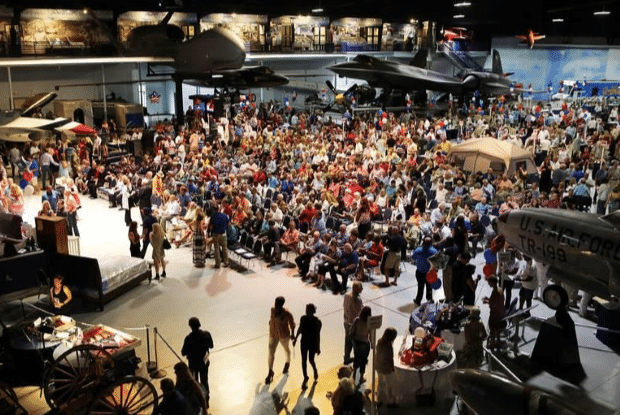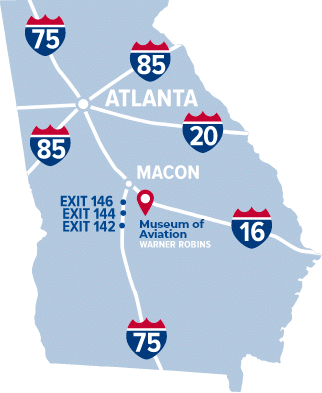This has been a bad year for wildfires. The National Interagency Fire Center reports that as of August 29th, over 7,291,750 acres (11,393 square miles) have been burned by over 44,000 fires in 2012. Those are mind-boggling numbers.
To put those numbers into perspective, that would be like burning almost a fifth of the total area of the state of Georgia. The Museum of Aviation is located in Houston County, Georgia, in the middle part of the state. 7,291,750 acres is equivalent to all but a small fraction of the total area of Houston County and the other 31 counties highlighted in the map below. (Data from The Georgia Statistics System: Cross Sectional Analysis)

The highlighted area in this map represents a total land area of 7,307,840 acres, a little more than the area burned by wildfires in the United States so far in 2012.
But these fires don’t just burn a lot of trees in remote areas of national forests. The Waldo Canyon Fire in Colorado forced over 32,000 residents of Colorado Springs and neighboring communities to evacuate. The United States Air Force Academy was partially evacuated. The fire destroyed at least 346 homes and killed two people. The Waldo Canyon Fire is the most expensive fire in Colorado State history with insurance claims totaling more than $352.6 million dollars. See some dramatic photos here.
The U.S. Air Force has taken an active role in the effort to fight the fires.
C-130 Hercules cargo planes—depot managed and maintained here at Robins Air Force Base—play an important role as heavy “air tankers.” The C-130s carry a Modular Airborne Fire Fighting System or “MAFFS,” which is a self-contained aerial firefighting system owned by the U.S. Forest Service. MAFFS can discharge 3,000 gallons of water or fire retardant in less than five seconds. MAFFS-equipped C-130s are operated by four military units: The 153rd Airlift Wing, Wyoming Air National Guard; 146th Airlift Wing, California Air National Guard; 145th Airlift Wing, North Carolina Air National Guard; and the 302nd Airlift Wing, U.S. Air Force Reserve Command.
This is the first year since 2008 that all four MAFFS wings have been activated simultaneously. Last Friday, August 24th, they reached a major mission milestoneby dropping the 2 millionth gallon of retardant for the season.

A Modular Airborne Fire Fighting System-equipped C-130 drops retardant on a section of the Waldo Canyon fire near Colorado Springs, Colo. June 26, 2012. (U.S. Air Force photo by Tech. Sgt. Thomas J. Doscher)

Flight line personnel prepare to insert a Modular Airborne Fire Fighting System unit into a C-130 Hercules aircraft assigned to the 145th Airlift Wing, North Carolina Air National Guard prior to its departure from Charlotte, N.C., June 23, 2008. (U.S. Air Force photo by Tech. Sgt. Brian E. Christiansen)

A MAFFS-equipped C-130 Hercules supports fire suppression efforts near Colorado Springs, Colo., June 27, 2012. (U.S. Air Force photo/ Staff Sgt. Stephany D. Richards)
Fighting fires from the air is dangerous work. On July 1st, a North Carolina Air National Guard C-130 crashed while fighting a fire in South Dakota. Four Airmen died and two others were seriously injured. It was the first crash in the MAFFS’s 40-year history and the incident is under investigation.
The four men who died are Lt. Col. Paul K. Mikeal, 42, of Mooresville, N.C.; Maj. Joseph M. McCormick, 36, of Belmont, N.C.; Maj. Ryan S. David, 35, of Boone, N.C.; and Senior Master Sgt. Robert S. Cannon, 50, of Charlotte.
I’m grateful to them for their service and my heart goes out to their families and friends.
In the Rapid City, South Dakota Journal, Gene Rogers, a wildfire consultant from Oregon, says that pilots of air tankers have to deal with smoke, hilly terrain, convection drafts and low-altitude turbulence. In the United States in the past 60 years, an average of about 1.5 large air tankers have crashed each year. Rogers says, “Flying a large aircraft anywhere from 150 feet to 300 feet over undulating terrain is outside the box of traditional pilot expectations. It’s a difficult mission.”

C-130 equipped with a MAFFS system sprays retardant over the Black Crater Fire in Oregon. U.S. Forest Service photo by Thomas Iraci, 22 October 2007.
Helicopters also play an important role in fighting wildfires. For example, California Air National Guard HH-60G Pave Hawk rescue helicopters and air crews, assigned to the 129th Rescue Wing, helped fight the Jawbone Complex Fire in Kern County. Pave Hawks are also managed here at Robins AFB.

A California Air National Guard HH-60G Pave Hawk rescue helicopter releases 500 gallons of water on the Jawbone Complex Fire in Kern County, Calif., Aug. 15, 2012. During the support of the Bureau of Land Management, Kern County fire, and Cal Fire; the 129th Rescue Wing has performed more than 120 bucket drops. (Air National Guard photo by Master Sgt. Julie Avey/Released)

A California Air National Guard HH-60G Pave Hawk rescue helicopter fills a bucket with 500 gallons of water on Aug. 15, 2012. (Air National Guard photo by Master Sgt. Julie Avey/Released)
As important as air power is in the fight against wildfires, few fires are contained from the air. Fire fighters on the ground—called “Hot Shots”—dig and cut containment lines. And Air Force people have been helping with that, too.

Firefighters from the Vandenberg Air Force Base, Calif., Hot Shots cut a fire line in the Mount Saint Francois area of Colorado Springs, Colo., while helping to battle several fires in Waldo Canyon on June 28, 2012. (U.S. Air Force photo/Master Sgt. Jeremy Lock)

Whitewater-Baldy Complex wildfire, Gila National Forest, New Mexico, June 6th, 2012. Photo by Kari Greer. Credit USFS Gila National Forest.

Brad Mabery downs a tree with a chainsaw while cutting and clearing a fire line in the Mount Saint Francois area of Colorado Springs, Colo., June 28, 2012. Mabery and the rest of the firefighters with the Vandenberg Air Force Base, Calif., Hot Shots are helping to battle several fires in Waldo Canyon. (U.S. Air Force photo/Master Sgt. Jeremy Lock)
While important, the U.S. Air Force’s contribution is only part of the huge effort to fight wildfires. I salute the thousands of brave men and women who risk their lives—thank you!

A sign in the area of the North Pass Fire in northwestern California. The fire, which started on August 18, 2012, is still burning and the estimated containment date is September 10th. Photo by Rebeca Franco, USFS. Info here and photos here.
– Mike Rowland, Curator












